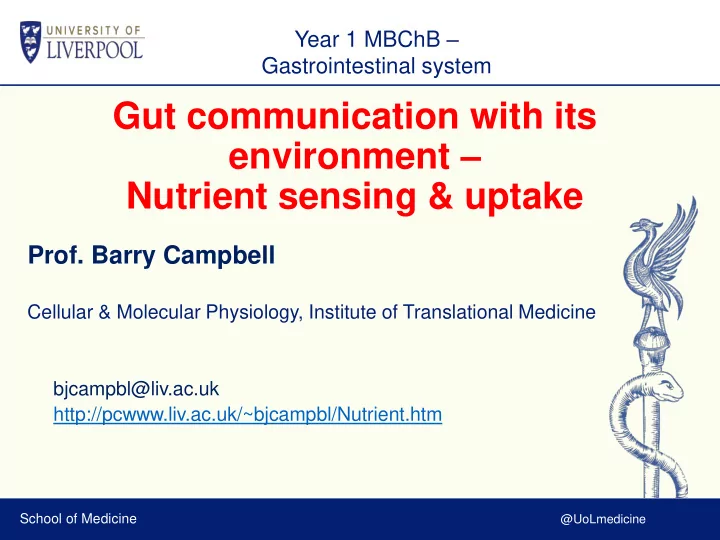

Year 1 MBChB – Gastrointestinal system Gut communication with its environment – Nutrient sensing & uptake Prof. Barry Campbell Cellular & Molecular Physiology, Institute of Translational Medicine bjcampbl@liv.ac.uk http://pcwww.liv.ac.uk/~bjcampbl/Nutrient.htm School of Medicine @UoLmedicine
Learning Outcomes: Describe the taste receptors including the different types and ➢ taste modalities Explain nutrient sensing in the GI tract and the “ Gustotopic ” map ➢ of the tongue. Describe the taste receptors in the gut (stomach, gallbladder, ➢ small intestine, colon) and define and explain the relevant nutrient transport mechanisms Nutrient sensing and the potential for future medicines ➢
The tongue and taste ➢ Taste receptors in the tongue send information via VII and IX cranial nerves to reach the nucleus of the solitary tract (NTS) in brain stem. ➢ Initiate visceral reflexes to gut to prepare for incoming meal (Cephalic response) TASTE Gustatory NTS - Tongue afferent BRAIN neurons STEM Efferents VII, IX and X Taste buds/cells - Chemosensitive receptors
Taste, olfaction and gustatory responses ➢ The nucleus of the solitary tract projects to a specific gustatory nucleus in the thalamus, and from there to the insular cortex. ➢ A great deal of what we call taste is based on olfactory signals. During a nasal infection the olfactory receptors are injured or blocked, we lose ~90% of our ability to appreciate flavours. Main olfactory pathway runs from the olfactory bulb to the primary olfactory cortex (piriform cortex) on the underside of the temporal lobe Visceral responses • Salivary secretion • Gastric juice • Pancreatic secretion • Gallbladder contraction
Taste in the mouth – the gustotopic map Old model
Taste in the mouth – the gustotopic map New model Old model Chandrashekar et al. Nature 2006, 444; 288-94
Lingual Epithelium Taste Receptors Taste Receptor 1 ( T1R) has three members. T1R1, T1R2 and T1R3 ➢ Combination of T1R1+T1R3 = taste of L-amino acids (umami), taste of monosodium glutamate. ➢ Combination of T1R2+T1R3 = Sweet taste. Taste receptor 2 family or T2Rs (~30 separate genes encode members of T2R family) = bitter taste. ➢ These receptors are G protein (guanine nucleotide binding protein) coupled receptors (GPCRs). ➢ G-protein that couples to these receptors is called Gustducin, belonging to the Transducin family of GPCRs.
Other Lingual Epithelium Taste Receptors ENaC – epithelial Sodium (Na + ) channel is also found in taste receptors, where it plays an important role in saltiness perception. PKD2L1 - reported to be a candidate receptor for sour taste based on molecular biological and functional studies Roles still being defined
In much the same way as the tongue, the gut also tastes what we eat
Gut enteroendocrine cells (EECs) - nutrient sensors Nerve endings that enter the villi do not reach the luminal content. Hence EECs are central to the chemosensing pathway of the intestinal tract. ➢ There are at least 12 different EEC populations of the GI tract producing >20 hormones. ➢ Nutrient sensing GPCRs are expressed on the luminal membrane of EECs. ➢ Nutrient sensing through these receptors leads to secretion of key regulatory gut hormones
Taste receptors on gut endocrine cells control the release of hormones in response to nutrients Region Hormone/Nutrient/Taste receptors/ Action Cell G cell Stomach P/D1 cell Duodenum I cell SGLT-1 Jejunum Enterocyte ileum L cell Colon L-cell
Nutrient sensing & the cholecystokinin (CCK) I cell ▪ Long chain Cease food intake Small intestine - fatty acids lumen ▪ Protein/AAs Reduce gastric ▪ Bitter - emptying + Apical I-cell CNS + pancreas CCK CELL + CCK receptors gallbladder basolateral + Nodose ganglion CCK circulation Vagus nerve
Sweet sensing & regulation of glucose absorption SGLT1 - major route for the absorption of dietary sugars from intestinal lumen into enterocytes. Glucose also stimulates gut hormone secretion (GLP-1) – stimulates pancreas insulin release, increasing glucose uptake to tissues (and enhancing enterocyte glucose uptake via increasing expression of SGLT1 and GLUT2 in enterocytes Enterocyte INSULIN GLP-1R + glucose Beta cell GLP-1R GLP-1 Glucagon- release like-peptide 1 + - An incretin
Taste receptor targeting to prevent and treat obesity and diabetes • In disease, disturbances or adaptations in the expression or sensitivity of taste receptors and their signalling pathways may affect digestive behaviour and metabolism Future clinical potential? ➢ Compounds that block activation of the gut’s taste receptors might serve as appetite suppressants – e.g. Bitter agonists ➢ Selective targeting of taste receptors on cells in the gut to release hormones that signal a feeling of fullness, thereby mimicking the physiological effects of a meal and fooling the body into thinking that it has eaten, could replacement bariatric surgery approaches to cause profound weight loss ➢ Diabetes might be treated by activating the taste receptors on gut L cells so that they release GLP-1 to augment insulin release.
Recommend
More recommend